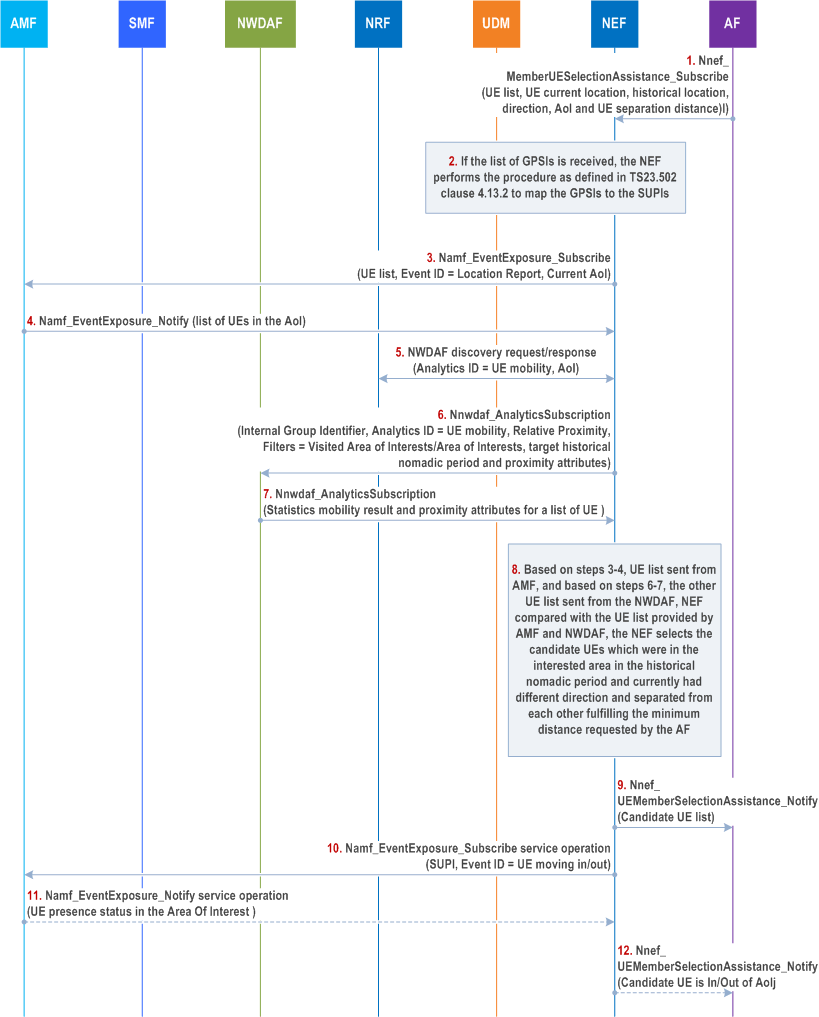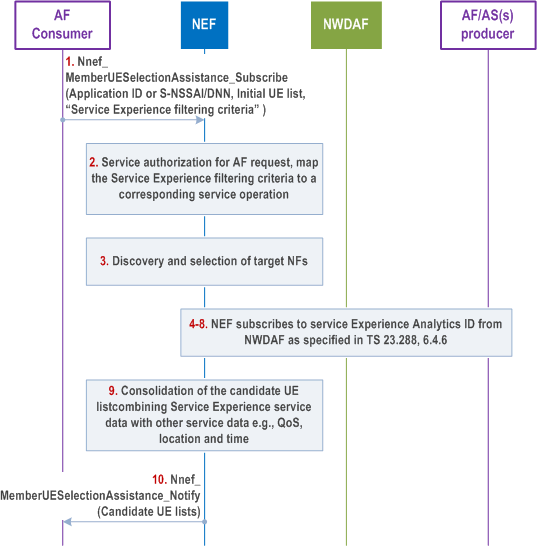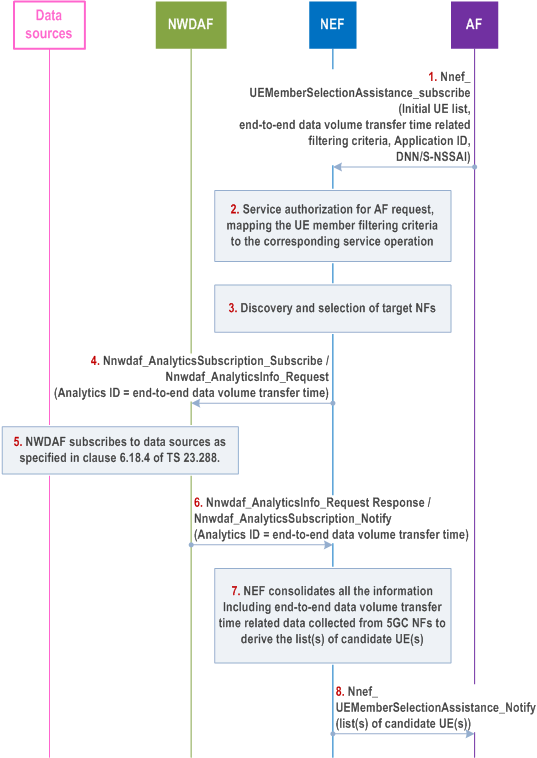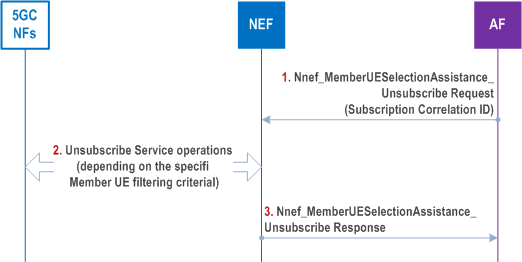Content for TS 23.502 Word version: 18.5.0
1…
4.2.2.2.2
4.2.2.2.3…
4.2.2.3…
4.2.3…
4.2.3.3
4.2.4…
4.2.6
4.2.7…
4.2.9…
4.2.11…
4.2.11.5…
4.3…
4.3.2.2.2
4.3.2.2.3…
4.3.3…
4.3.3.3
4.3.4…
4.3.4.3
4.3.5…
4.3.5.2…
4.3.5.4…
4.3.5.6…
4.3.6…
4.4…
4.5…
4.9…
4.9.1.3…
4.9.2…
4.11…
4.11.1…
4.11.1.2.2
4.11.1.2.3
4.11.1.3…
4.11.1.3.3…
4.11.1.4…
4.11.1.5…
4.11.2…
4.11.3…
4.12…
4.12.6…
4.12a…
4.12b…
4.13…
4.13.4…
4.13.6…
4.14…
4.15…
4.15.3.2.5…
4.15.4…
4.15.6…
4.15.6.7…
4.15.6.13…
4.15.6.14…
4.15.9…
4.15.9.4…
4.15.13…
4.15.13.4…
4.16…
4.16.4…
4.16.8…
4.16.11…
4.16.14…
4.16.15…
4.17…
4.17.9…
4.18…
4.19…
4.22…
4.23…
4.23.7…
4.23.7.3.3
4.23.7.3.4…
4.23.9…
4.23.9.4…
4.23.11…
4.24…
4.25…
4.25.6…
4.26…
5…
5.2.3…
5.2.5…
5.2.6…
5.2.7…
5.2.8…
5.2.9…
5.2.12…
5.2.18…
A…
E…
F…
G
H…
4.15.13.4 Specific procedure for the 5GC assistance to member UE selection based on the UE's current location, historical location and direction and UE separation distance
4.15.13.5 Specific procedure for Service Experience Member UE filtering criteria
4.15.13.6 Specific procedure for end-to-end data volume transfer time related member UE filtering criteria
4.15.13.7 Member UE selection assistance information unsubscribe procedure
...
...
4.15.13.4 Specific procedure for the 5GC assistance to member UE selection based on the UE's current location, historical location and direction and UE separation distance p. 498

Step 1.
AF requests 5GS assistance to support the Member UE selection by considering the UE's historical location, UE's current location, direction and UE separation distance. AF includes the UE lists and the following criteria as part of the member UE selection request:
Step 2.
- UE historical location: The Target AoI where the UEs have been roving over the historical nomadic period before moving into the FL coverage area.
- UE current location: The current AoI which is the coverage area of the FL training server where the selected UEs located in to participate in the FL operation.
- UE Direction: Select the UE with the different direction in the FL coverage Area.
- UE separation distance: Select UEs that are geographically separated, fulfilling the separation distance no smaller than the certain predefined separation distance.
NEF translates the GPSIs to SUPIs and maps the filtering criteria into the corresponding UE filtering information.
Step 3-4.
The NEF invokes Namf_EventExposure_Subscribe service operation with the UE list, the current AoI and event ID = Location report. AMF will provide a list of UEs that are within the current AoI to the NEF using the Namf_EventExposure_Notify service operation. The NEF obtains the list of possible member UEs from AMF within the current AoI.
Step 5.
In order to identify the appropriate NWDAF which can provide analytics output to derive the visited AOI info and get the UE direction for the possible target member UEs above, the NEF initiates NWDAF discovery request (Analytics ID = UE mobility/Relative Proximity, AOI = Target AOI) with UE list received from step 4.
Step 6-7.
The NEF invokes NWDAF Analytics Info request (UE list received from step 4, Analytics ID = UE mobility, Relative Proximity, Filters include "Visited AoI = Target AOI", "target period = historical nomadic period" and "proximity attributes"). In a response, NWDAF provides a list of UEs that were ever roving within the target AOI, at the minimum, over the historical nomadic period. Additionally, NWDAF provides a list of UEs location in the order of which the UE passes through. Thus, the NEF gets the corresponding statistics of UE mobility, the UE's direction and distance between UEs in the group/list.
Step 8-9.
Based on the information provided by the AMF and NWDAF, the NEF can determine the FL candidate UEs which are now within the FL coverage area but were roving within the target AOI over the historical nomadic period and UE with the different direction and separated from each other fulfilling the minimum distance threshold as requested by AF. The NEF notifies AF for such UE candidate list.
Step 10.
The NEF also needs to consider the list of UEs which are now within the FL coverage area, but may move out of the FL coverage area. Therefore, for each UE in the candidate list in steps 8-9, the NEF invokes the Namf_EventExposure_Notify service with UE ID = SUPI, Event ID=UE moving in/out of AOI in order to keep tracking the movement of the UE(s).
Step 11-12.
If step 10 identifies any UE which is moving out of the FL coverage area, the NEF may further notify the AF of the given UE which is moving out the coverage.
4.15.13.5 Specific procedure for Service Experience Member UE filtering criteria p. 499
4.15.13.5.1 General p. 499
An AF may invoke Nnef_MemberUESelectionAssistance_Subscribe service operation with a Service Experience filtering criteria for receiving a list of UEs that fulfil such criteria.
In addition to the mandatory parameters, the AF may also include in the request:
- Service Experience filtering criteria.
- An Area of Interest: location area of the candidate UEs.
- Time windows for selecting the candidate UEs: start time and stop time.
- Service Experience contribution weights.
- Service Experience Type.
4.15.13.5.2 Member UE Selection Assistance with Service Experience filtering criteria p. 500

Step 1.
AF subscribes to the Member UE selection assistance functionality by sending Nnef_MemberUESelectionAssistance_subscribe request including the Application Identity, AoI, DNN/S-NSSAI, DNAI(s), Service Experience Type and contribution weights associated to location, time window, Application ID and Service Experience type.
Step 2.
NEF verifies the authorization of the AF Request and identifies which information needs to be collected and executed based on the Service Experience filtering criteria provided by the AF.
Step 3.
If S-NSSAI/DNN and DNAI(s) are not included in the request from the AF, the NEF derives the S-NSSAI, DNN and DNAI(s) which this Application has access to. NEF discovers and selects the NWDAF(s) by invoking Nudm_UECM_Get or Nnrf_NFDiscovery_Request including Analytics ID = Service Experience, AoI, S-NSSAI, etc.
Step 4.
NEF sends an Analytics request/subscribe to NWDAF by invoking a Nnwdaf_AnalyticsInfo_Request or a Nnwdaf_AnalyticsSubscription_Subscribe , including Analytics ID = Service Experience, Application ID, S-NSSAI, DNN, AoI, DNAI(s), and target UEs based on the initial list obtained from the AF.
Step 5-7.
Procedures as specified in clause 6.4.6 of TS 23.288 are followed.
Step 8.
The NWDAF provides the data analytics, i.e. the observed Service Experience (which can be a range of values) to the consumer NF by means of either Nnwdaf_AnalyticsInfo_Request response or Nnwdaf_AnalyticsSubscription_Notify , depending on the service used in step 4.
Step 9.
Based on the Analytics report received from the NWDAF, NEF consolidates results and derives the list(s) of candidate UE(s). For applying that, NEF may use the Service Experience type provided by the AF consumer in the filtering information and use operator policies to interpret a customized MoS. Additionally, NEF may use the contribution weight associated to an application and a Service Experience Type (e.g. AI/ML traffic) and apply them to a location and time window, as provided by the AF consumer, to be used as reporting thresholds when selecting candidate Member UEs, e.g. the NEF may select a UE with a specific Service Experience Type as a Member UE candidate, if the associated Service Experience fulfils the threshold for Service Experience filtering criteria provided by the AF.
Step 10.
NEF sends a Nnef_MemberUESelectionAssistance_Notify request to the AF including the list(s) of candidate UE(s) and additional information.
4.15.13.6 Specific procedure for end-to-end data volume transfer time related member UE filtering criteria p. 501
4.15.13.6.1 General p. 501
An AF may invoke Nnef_MemberUESelectionAssistance_Subscribe service operation with end-to-end data volume transfer time related filtering criteria for receiving a list of UEs that fulfil the filtering criteria.
In addition to the mandatory parameters, the AF may also include in the request:
- End-to-end data volume transfer time filtering criteria: this may include the average end-to-end data volume transfer time for a specific data volume between UE and AF and/or the variance of the end-to-end data volume transfer time.
- An Area of Interest: location area of the candidate UEs.
- Time windows for selecting the candidate UEs: start time and stop time.
- Data Volume UL/DL: the expected or observed data volume from UE to AF or from AF to UE which may be used to derive the end-to-end data volume transfer time analytics.
- The target number of data transmission repetitions or target time interval between data transmissions.
- A request for geographical distribution of UEs.
4.15.13.6.2 Member UE Selection assistance with end-to-end data volume transfer time related filtering criteria p. 502

Step 1.
AF subscribes to the member UE selection assistance functionality by invoking Nnef_MemberUESelectionAssistance_subscribe request including the Application ID, DNN/S NSSAI, AoI, and the end-to-end data volume transfer time related filtering criteria including the average end-to-end data volume transfer time and/or the variance of the transfer time, the Data Volume UL/DL, the target number of data transmission repetitions or target time interval between data transmissions, request for geographical distribution (i.e. the AoIs) of the UEs.
Step 2.
NEF verifies the authorization of the AF Request and identifies which information needs to be collected and executed based on the end-to-end data volume transfer time related filtering criteria provided by the AF.
Step 3.
S-NSSAI/DNN are not included in the request from the AF, the NEF derives the S-NSSAI and DNN which this Application has access to. NEF discovers and selects the NWDAF(s) by invoking Nudm_UECM_Get or Nnrf_NFDiscovery_Request including Analytics ID = E2E data volume transfer time, AoI, S-NSSAI, etc.
Step 4.
NEF sends an Analytics request/subscribe to NWDAF by invoking Nnwdaf_AnalyticsSubscription_Subscribe / Nnwdaf_AnalyticsInfo_Request including Analytics ID = E2E data volume transfer time, Application ID, DNN, S-NSSAI, AoI, and target UEs based on the initial UE list obtained from the AF, the target number of data transmission repetitions or target time interval between data transmissions, the Data Volume UL/DL, request for geographical distribution (i.e. the AoIs) of the UEs, etc.
Step 5.
The NWDAF collects data from multiple sources for end-to-end data volume transfer time analytics as specified in clause 6.18.2 of TS 23.288.
Step 6.
The NWDAF provides the required output analytics to the consumer NF as specified in clause 6.18.4 of TS 23.288 by means of either Nnwdaf_AnalyticsInfo_Request response or Nnwdaf_AnalyticsSubscription_Notify , depending on the service used in step 4.
Step 7.
Based on the analytics received from the NWDAF, the NEF consolidates results and derives the list(s) of candidate UE(s) that fulfil the filtering criteria requested by the AF. The NEF may use the average and/or the variance of end-to-end data volume transfer time of specific volumes of UL/DL data indicated by the AF to derive the list(s) of candidate UEs that meet the requirements from the AF.
Step 8.
NEF sends a Nnef_MemberUESelectionAssistance_Notify request to the AF including the list(s) of candidate UE(s) and additional information.
4.15.13.7 Member UE selection assistance information unsubscribe procedure p. 503
This clause describes the procedure that an AF decides to unsubscribe the previous subscription for Member UE selection assistance information in NEF.

Step 1.
AF deletes the previous subscription for Member UE selection assistance information by sending Nnef_MemberUESelectionAssistance_unsubscribe request including the Subscription Correlation ID.
Step 2.
NEF interacts with different 5GC network functions to delete the required information subscription for each UE in the list of target UE(s). The set of interactions between NEF and among 5GC NFs are dependent on the Member UE filtering criteria that AF subscribed in clause 4.15.13.1.
Step 3.
NEF sends a Nnef_MemberUESelectionAssistance_unsubscribe response to the AF with the operation execution result indication.